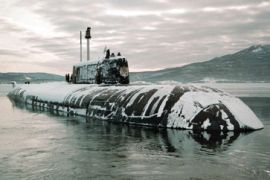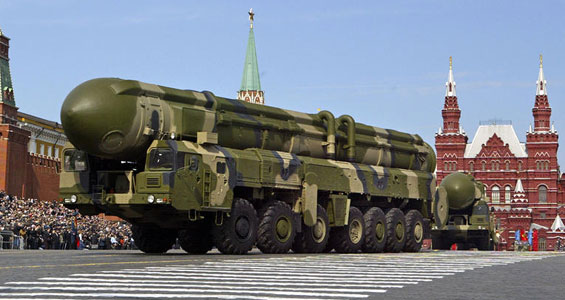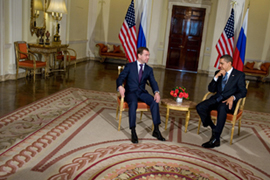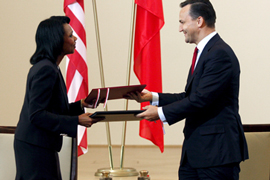Russia and US hasten nuclear thaw
Obama and Medvedev race against time to plot next phase in nuclear arms reduction.

 |
| Despite progress on arms reduction Russia has been accused of giving mixed signals to the US [AP] |
As a December deadline looms, what was once an arms race between two nuclear superpowers is now a race against time to plot the next phase in nuclear arms reduction.
In October 1962, at the height of the Cold War, the world edged perilously towards nuclear conflict.
| IN VIDEO |
|
|
| Hans Blix on North Korea’s nuclear fallout
Russia and US race to sign nuclear treaty |
| More Videos… |
The Soviet Union had placed nuclear missiles on Cuba to protect its communist ally from the threat of an attack from the United States.
When the Americans discovered the weapons, they decided to do everything possible to ensure their removal.
The crisis ended with a compromise. The US would withdraw all missile sets in Turkey bordering the USSR and Moscow would remove all missiles from Cuba.
Since the 1960s, compromises have been at the heart of a series of arms limitation treaties.
Victor Kremenyuk, of the Moscow Institute for American Studies, says: “Only by staring annihilation in the face did the two superpowers step back from the edge.”
‘Mad’ era
The first round of strategic arms limitation talks in 1969 known as Salt I and II placed specific limits on each sides number of nuclear weapons.
 |
| North Korea’s achievement in becoming a nuclear state has raised concerns [AFP] |
The grim political concept of Mutually Assured Destruction, or Mad, saw both powers agreeing, at least publicly, to match each other missile for missile.
A year earlier, the nuclear Non-Proliferation Treaty established the US, USSR, Britain, France and China as the world’s “nuclear weapon states”.
Other nations were prohibited from acquiring the weapons.
At the time 187 countries committed to the goal with a view to eventual nuclear disarmament.
But the reality was that a series of countries would, over the next few decades, pursue and possess nuclear arms.
Some states like South Africa produced weapons and then soon disassembled them.
Other nations like India and Pakistan would use their nuclear arsenals as a deterrent against each other.
Countries like Israel on the other hand remain strategically ambiguous about the possibility of having their own programme, whilst repeatedly accusing Syria and Iran of possessing nuclear arms
As North Korea joins the club of nuclear nations, many are questioning whether a nuclear weapons free world will ever be possible.
One person who believes it can is Barack Obama, the US president, who together with Dmitry Medvedev, his Russian counterpart, is taking a significant step towards consigning the Cold War nuclear arms race era to history.
New start
In the last 50 years a dozen different arms limitation treaties have led to an 80 per cent reduction in nuclear and other offensive weaponry.
 |
| Medvedev, left, and Obama ordered work to begin hastily on a new treaty [AFP] |
US and Russian missiles no longer automatically target each other and nuclear forces are no longer operated as if the two nations are adversaries.
Building on the earlier Salt I and II agreements, the strategic arms reduction treaty (Start I) required the further reduction of US and Soviet, now Russian, nuclear arms.
Start I was negotiated in the 1980s, ratified by presidents George W Bush and Mikhail Gorbachev, and implemented in 1994.
It reduced the numbers of US and Soviet long-range missiles from 10,000 per side to 6,000 and the number of strategic delivery systems including bombers, land and submarine missiles to 1,600 each.
On December 5, Start I will expire.
At their first meeting in April, Medvedev and Obama ordered their governments to start hastily working on a successor to the treaty.
Top level diplomats from both sides have held a series of meetings in the last few weeks to lay down the basis of a draft treaty.
The presentation of the draft is expected to coincide with Obama’s first official visit to Moscow in July.
The new treaty is expected to see further cuts to the number of warheads to between 1,000 and 1,500 each.
However, the treaty faces a series of obstacles.
Shield friction
Russia remains strongly opposed to US plans to place elements of a missile defence shield in Poland and the Czech Republic.
 |
| The United States and Poland signed a deal over a missile defence shield in 2008 [EPA] |
Moscow insists that the locating of 10 interceptor missiles in central Europe compromises its national security.
The former Bush administration, originally behind the missile shield plan, say the system was always planned as a deterrent for ‘rogue nations’ such as Iran.
Russia has also been accused of sending mixed signals to Washington.
In March, Medvedev announced sweeping plans to upgrade the country’s crumbling armed forces.
The plans also include improvements to the nation’s nuclear capabilities.
This year, Russia is expected to start construction of two new nuclear-armed submarines in the northern port city of Severodvinsk.
Race against time
Konstantin Kosachev, head of the State Duma foreign affairs committee, says it is a priority for the country to build a modern military force.
“Only then will Russia be seen as an equal by the West … only then will it be taken seriously,” he says.
Another hurdle to the treaty may also be the short amount of time left to draw up the new agreement.
Some analysts fear the new document may be incomplete when the old treaty expires in December.
What was once an arms race between two nuclear super powers is now a race against time to plot the next phase in nuclear arms reduction.
